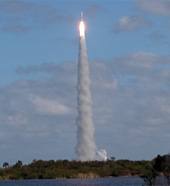A little girl from England gave it its name, and Walt Disney was so taken by its discovery he named a cartoon character after it. The discovery of Pluto, Roman god of the underworld because it is perpetually in the dark, caused a tremendous stir. The artist's rendition above shows Pluto with the shadow of one of its moons, Charon, passing on the left. Before it was truly seen in 1930, four other objects just like it were discovered, and categorized as ice dwarfs, meaning not big enough to be planets, and consisting mostly of rock and ice. Pluto is a "dwarf planet" composed of 70% rock and 30% ice, with a poisonously cold atmosphere of which little is known, except it holds nitrogen, carbonmonoxide and methane. It's freezing out there. But don't think it was "downgraded" because it's no longer considered a planet. It is now far more interesting and mysterious. Ice dwarfs are the most populous objects in space, and 4 billion years ago they helped to form Earth by bringing it the matter from which our planet is made - water, for one. Water also arrived here via comets.

Pluto, if it were closer to the sun, would behave like a comet as its ice melted in an erratic orbit. Its present orbit is eccentric, in fact as the smallest object in our star-sol system, it rotates in reverse of the 8 planets. It even interferes within the orbit of Neptune. Pluto has always been thought to have one satellite (moon) called Charon, another mythological character - the ferryman of the River Styx. But there may be others. We've discovered at least two, seen in the picture below.
Pluto revolves around the sun ONCE EVERY 248 YEARS! This dwarf planet is the subject of incredible curiosity, and guess what: it takes NINE YEARS to get there and WE'RE ON THE WAY!! At over 10 miles a second! A voyage back in time. And we only get one chance.

This is "NEW HORIZONS" our satellite probe, as it made its flyby in 2007 past Jupiter to pick up speed. Back then I posted about it Jupiter Flyby This Morning New Horizons was launched in 2006 and as it makes its 9-year journey to Pluto, will gather information about our star-sol system previously unknown. Out by Neptune is an area called the Kuiper Belt, of which Pluto was thought to be a part because of its small size. As you see below, "Xena" was thought to be our 10th "planet".
NASA's New Horizons will study everything from Earth to Pluto to the Kuiper Belt and beyond. It is the fastest craft ever launched, and when it passed Jupiter in February of 2006, the Jovian gravity accelerated it away from the sun by an additional 9,000 miles per hour. That pushed it up to 52,000 mph as it hurls towards Pluto, expected to reach it by July of 2015. Even if we blow up the Earth, New Horizons will go on and on and on.....After passing Jupiter, NH began sending back its precious data in March. This incredible craft has undergone a full range of system and instrument checkouts, callibrations, software enhancements, and propulsive maneuvers to adjust its trajectory accurately. The image below is what NH sees of Pluto. Just LOOK at all this!!

We expect to stay five months at Pluto and its (now) 3 moons, conducting geological experiments, mapping the surface, temperature and atmospheric studies, you name it. But it will extend its mission into the ancient, rocky, icy, planetary building blocks of the Kuiper Belt. Just amazing. Fantastic. The information we retrieve will form the foundation of future missions. Below is an artist's conception of Pluto and Charon.
Below is a launch photo of January 19, 2006.
Digital image of Pluto below. Right now, Pluto is in the stage all planets once went through, but hasn't gone as far, hence its corrected category. I can't help wondering what the sophisticated cameras of NH will reveal - will these electro-magnetic spectrum eyes show us ice caps? mountains? craters? The study of this world will most definitely re-write much of what we know of our star-sol system, indeed our galaxy, how it formed, and what's ahead.

Basics courtesy of NASA, Science Daily, JPL, NHWS, Gryphon.




















































11 comments:
I love our little Pluto! My eldest has a shirt that says 'Pluto will always be my planet' LOL
be well,
Dawn
http://journals.aol.com/princesssaurora/CarpeDiem/
And to think Earth is all there is!
interesting as always
..interesting read and info!
Gem :)
bummer your pictures don't show!
good entry Cathy. Interesting and well, let's hope we are all around to see the results of that trip!
Thanks for posting this, Cathy, Pluto is one of those enigmas of the solar system. Can't wait for 2017!
Guido
http://journals.aol.co.uk/pharmolo/NorthernTrip
Fascinating! - BArbara
Good brief and this post helped me alot in my college assignement. Thank you seeking your information.
Pluto is, and always will be a planet. It is cool that current data now strongly suggests that Pluto is larger than Eris. The New Horizons spacecraft will "barring a mishap" to quote Alan Stern, the Principal Investigator of the mission, measure Pluto's diameter, which will, hopefully, prove, once and for all, that Pluto is larger than Eris. I am glad there are more Pluto huggers out there than just me!
The comment that "Pluto rotates in reverse of the 8 planets" implies that our solar system has only 8 planets, which is not the case. Dwarf planets are planets too, in spite of the controversial decree by four percent of the IAU. That decree was opposed in a formal petition by an equal number of professional astronomers, led by New Horizons Principal Investigator Dr. Alan Stern. Stern is the person who coined the term dwarf planet, but he never intended it to mean these objects are not planets at all. Instead, he wanted to create a new class of planets for objects large enough to be rounded by their own gravity (which makes them geologically complex, just like the larger planets) but not large enough to gravitationally dominate their orbits.
Any planet brought close enough to the Sun or to its parent star would start behaving like a comet in that its atmosphere would begin to sublimate and form a tail. Mercury actually has such a tail. Giant exoplanets in close orbits of their parent stars have tails. This does not make any of these objects comets. Unlike comets, Pluto has a stable orbit, is much larger than comets are, and never enters the inner solar system. As far as eccentric orbits, there are giant exoplanets with orbits around their stars that are much more eccentric than Pluto's orbit.
Post a Comment